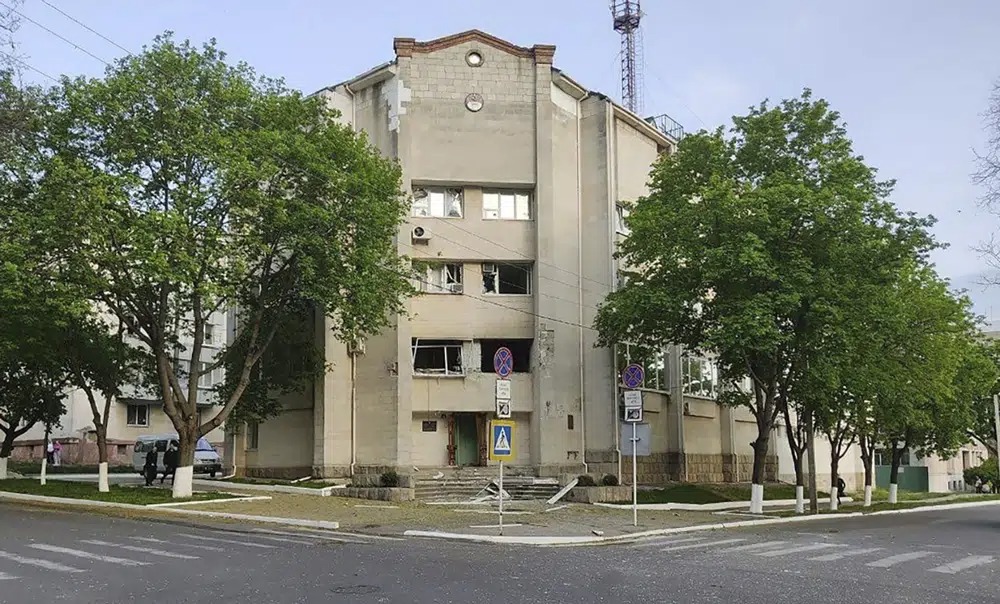Moldova’s national intelligence agency said Monday that Russia could launch a new offensive next year with an aim to “create a land corridor” through southern Ukraine to the Moscow-backed breakaway region of Transnistria.
Moldova’s Intelligence and Security Services, or SIS, released a statement on Monday aimed at clarifying comments made by the agency’s head, Alexandru Musteata, who said during an interview with a local TV station that Kremlin forces could aim to cross into the separatist region of Moldova early next year.
“The question is not whether the Russian Federation will launch a new offensive in the direction of Moldovan territory, but when it will happen: either at the beginning of the year, in January, February, or later, in March, (or) April,” Musteata told TVR Moldova, which released a teaser ahead of the Monday evening broadcast.
“But, judging by the information we have,” he said, “Russia can go further to create a corridor with the Transnistrian region, which is the territory of Moldova.”
“Then it will be possible to say with clarity that yes, they intend to get here, to unite,” Musteata said. “What will follow — their intentions towards Chisinau — we can discuss. But this is a real and very high risk.”
In a move likely aimed at avoiding a public panic, the SIS released a statement seeking to clarify Musteata’s comments, which it said refer to an “analysis of several scenarios in which the Russian Federation would attempt, including a land invasion through the north of Ukraine, towards the Republic of Moldova.”
“We specify that the director of the SIS mentioned that the objective of the Russian Federation to create a land corridor to the Transnistrian region is still valid today, and a new offensive of the Russian Federation in this direction could take place in 2023,” the agency said.
And after the pre-recorded broadcast aired Monday, Musteata walked back his position somewhat, saying during an interview at the TVR Moldova studios that the “Transnistrian region remains at a fairly calm point.”
Transnistria broke away after a 1992 civil war but is not recognized by most countries. It extends roughly 400 kilometers (249 miles) between the eastern bank of the Dniester River in Moldova and the country’s border with Ukraine.
Since Russia invaded Ukraine on Feb. 24, concerns have flared in non-NATO, militarily neutral Moldova that the conflict could spread into the country via Transnistria. Russia bases about 1,500 troops nominally as “peacekeepers” in the breakaway region in a so-called frozen conflict zone. And at least one Russian official has spoken openly about snatching enough land in southern Ukraine to link up Russian-controlled areas from the mainland to Transnistria.
Whether Russia would be able to create such a corridor by April is questionable, as only last month, Russian forces withdrew from Kherson, which was the first major Ukrainian city to fall last winter and which is now back under Ukrainian control, though Russian forces have been shelling it pretty much daily. Kherson now could serve as a potential bridgehead for Ukrainian troops to advance toward Crimea, which Russia has occupied since 2014.
In April, tensions soared in Moldova — a former Soviet republic of about 2.6 million people that is one of Europe’s poorest countries — after a series of explosions hit Transnistria.
In late October, a Russian missile landed in the Moldovan town of Naslavcea near the Ukraine border which shook up residents there. Earlier this month, missile debris was also found in an orchard in another town close to the border, which also caused alarm.
Moldova, which has been suffering an acute energy crisis and skyrocketing inflation, has also experienced two massive power outages in recent months as a result of Russian strikes on Ukraine’s energy grid, to which Moldova’s Soviet-era systems remain interconnected.
(AP)












2 Responses
Moldova (previously known to us as “Bessarabia”) is NOT a NATO member at this time. However both Moldova and Romania are Romanian speaking countries (the difference is that Russia and the Soviet Union usually controlled what is not Moldova, or at least most of it, whereas Romania was always independent, at least nominally). If Moldova decided to merge with Romania (there is a movement to merge the two), then it would immediately become part of NATO, so that a Russian invasion would start World War III.
sounds like a stretch